Multiple Nodes Co-Carrier Cooperative Transmission in LEO Communication Networks: Developing the Diversity Gain of Satellites
Abstract
:1. Introduction
1.1. Literature Review
1.2. Motivations and Contributions
- Recognizing that UTs located at the beam-edge area could be covered by multiple satellites, we propose two promising cooperative transmission methods. In the first method, UTs receive multiple signal paths from numerous LEO nodes and combine them without processing selection. In this scheme, the receiver directly demodulates the received signals. To fully utilize the signals from different satellites, we then study a selection combination (SC) method where the strongest signal path is selected to perform the demodulation procedure.
- As there exists a significant beam gain difference at the beam-edge area and the beam-center area, we develop a co-carrier transmission-aided scheme based on the two cooperative methods. In detail, the beam-edge and beam-center UTs share the same resource block where the signals for these two users would be superposed as one signal after modulation. To separate the two signals, SIC is applied at the receiver.
- In order to evaluate the performance of the new methods, we derive the expressions of the ergodic sum-rate and outage probability. Moreover, we further consider the processing expense of the SC algorithm. At last, simulation results confirm the performance of the work.
- Both the proposed methods are energy efficient. The received signal of the co-carrier-based direct combination (DC) method could be enhanced by combining signals from multiple satellites without increasing the transmit power, while the co-carrier-based SC scheme enables the UT access to the satellite with the best channel condition.
2. System Model
3. Multiple Nodes Cooperative Transmission
3.1. Co-Carrier-Based Direct Combination
3.2. Co-Carrier-Based Selection Combination
4. Performance Analysis
4.1. Ergodic Rate
4.1.1. Co-Carrier-Based Direct Combination
4.1.2. Co-Carrier-Based Selection Combination
4.2. Outage Probability
4.2.1. Co-Carrier-Based Direct Combination
4.2.2. Co-Carrier-Based Selection Combination
4.2.3. Diversity Order Analysis
4.3. Impact of Selection Time-Slot in Co-Carrier-Based SC
5. Simulation Results
- “ESR-DC, sim”: numerical simulation of ergodic sum-rate for co-carrier-based DC;
- “ESR-SC, sim”: numerical simulation of ergodic sum-rate for co-carrier-based SC;
- “ESR-non, sim”: numerical simulation of ergodic sum-rate without cooperative transmission;
- “ER-DC-edge, sim”: numerical simulation of ergodic rate for UT k in co-carrier-based DC;
- “ER-SC-edge, sim”: numerical simulation of ergodic rate for UT k in co-carrier-based SC;
- “ER-non-edge, sim”: numerical simulation of ergodic rate for UT k without cooperative transmission;
- “ESR-DC, exp”: analytical expression of ergodic sum-rate for co-carrier-based DC;
- “ESR-SC, exp”: analytical expression of ergodic sum-rate for co-carrier-based SC;
- “ER-DC-edge, exp”: analytical expression of ergodic rate for UT k in co-carrier-based DC;
- “ER-SC-edge, exp”: analytical expression of ergodic rate for UT k in co-carrier-based SC.
- “OP-DC-edge, sim”: numerical simulation of outage probability for UT k in co-carrier-based DC;
- “OP-SC-edge, sim”: numerical simulation of outage probability for UT k in co-carrier-based SC;
- “OP-non-edge, sim”: numerical simulation of outage probability for UT k without cooperative transmission;
- “OP-center, sim”: numerical simulation of outage probability for beam-center UT;
- “OP-DC-edge, exp”: analytical expression of outage probability for UT k in co-carrier-based DC;
- “OP-SC-edge, exp”: analytical expression of outage probability for UT k in co-carrier-based SC;
- “OP-center, exp”: analytical expression of outage probability for beam-center UT.
5.1. Ergodic Rate
5.2. Outage Probability
6. Conclusions
Author Contributions
Funding
Data Availability Statement
Conflicts of Interest
References
- Wu, M.; Guo, K.; Li, X.; Nauman, A.; An, K.; Wang, J. Optimization design in RIS-assisted integrated satellite-UAV-served 6G IoT: A deep reinforcement learning approach. IEEE Internet Things Mag. 2024, 7, 12–18. [Google Scholar] [CrossRef]
- Chen, S.; Sun, S.; Kang, S. System integration of terrestrial mobile communication and satellite communication—The trends, challenges and key technologies in B5G and 6G. China Commun. 2020, 17, 156–171. [Google Scholar] [CrossRef]
- Ahmed, A.; Al-Dweik, A.; Iraqi, Y.; Damiani, E. Integrated terrestrial-wired and LEO satellite with offline bidirectional cooperation for 6G IoT networks. IEEE Internet Things J. 2024. early access. [Google Scholar]
- Neinavaie, M.; Kassas, Z.M. Unveiling Starlink LEO satellite OFDM-like signal structure enabling precise positioning. IEEE Trans. Aerosp. Electron. Syst. 2024, 60, 2486–2489. [Google Scholar] [CrossRef]
- Kassas, Z.M.; Kozhaya, S.; Kanj, H.; Saroufim, J.; Hayek, S.W.; Neinavaie, M.; Khairallah, N.; Khalife, J. Navigation with multi-constellation LEO satellite signals of opportunity: Starlink, OneWeb, Orbcomm, and Iridium. In Proceedings of the 2023 IEEE/ION Position, Location and Navigation Symposium (PLANS), Monterey, CA, USA, 24–27 April 2023. [Google Scholar]
- Neinavaie, M.; Khalife, J.; Kassas, Z.M. Acquisition, doppler tracking, and positioning with starlink LEO satellites: First results. IEEE Trans. Aerosp. Electron. Syst. 2022, 58, 2606–2610. [Google Scholar] [CrossRef]
- Qi, W.; Wang, H.; Xia, X.; Mei, C.; Liu, Y.; Xing, Y. Dynamic selection mechanism of access strategies in integrated satellite-terrestrial network. In Proceedings of the 2023 IEEE International Symposium on Broadband Multimedia Systems and Broadcasting (BMSB), Beijing, China, 14–16 June 2023. [Google Scholar]
- Liu, S.; Lin, J.; Xu, L.; Gao, X.; Liu, L.; Jiang, L. A dynamic beam shut off algorithm for LEO multibeam satellite constellation network. IEEE Wirel. Commun. Lett. 2020, 9, 1730–1733. [Google Scholar] [CrossRef]
- Yan, X.; Xiao, H.; An, K.; Zheng, G.; Tao, W. Hybrid satellite terrestrial relay networks with cooperative non-orthogonal multiple access. IEEE Commun. Lett. 2018, 22, 978–981. [Google Scholar] [CrossRef]
- Zhu, X.; Jiang, C.; Yin, L.; Kuang, L.; Ge, N.; Lu, J. Cooperative multigroup multicast transmission in integrated terrestrial-satellite networks. IEEE J. Sel. Areas Commun. 2018, 36, 981–992. [Google Scholar] [CrossRef]
- Lee, J.H.; Joo, J.S.; Kim, P.; Ryu, J.-G. Random beam-based non-orthogonal multiple access for massive MIMO low Earth orbit satellite networks. IEEE Access 2023, 11, 75725–75735. [Google Scholar] [CrossRef]
- Zhang, X.; Yue, X.; Li, T.; Han, Z.; Wang, Y.; Ding, Y.; Liu, R. A unified NOMA framework in beam-hopping satellite communication systems. IEEE Trans. Aerosp. Electron. Syst. 2023, 59, 5390–5404. [Google Scholar] [CrossRef]
- Jung, D.-H.; Im, G.; Ryu, J.-G.; Park, S.; Yu, H.; Choi, J. Satellite clustering for non-terrestrial networks: Concept, architectures, and applications. IEEE Veh. Tech. Mag. 2023, 18, 29–37. [Google Scholar] [CrossRef]
- Ge, R.; Cheng, J.; An, K.; Zheng, G. Non-orthogonal multiple access enabled two-layer GEO/LEO satellite network. In Proceedings of the 2021 29th European Signal Processing Conference (EUSIPCO), Dublin, Ireland, 23–27 August 2021. [Google Scholar]
- Li, G.; Li, T.; Yue, X.; Hou, T.; Dai, B. High reliable uplink transmission methods in GEO-LEO heterogeneous satellite network. Appl. Sci. 2023, 13, 8611. [Google Scholar] [CrossRef]
- Gu, P.; Li, R.; Hua, C.; Tafazolli, R. Dynamic cooperative spectrum sharing in a multi-beam LEO-GEO co-existing satellite system. IEEE Trans. Wirel. Commun. 2022, 21, 1170–1182. [Google Scholar] [CrossRef]
- Jia, D.; Jia, J.; Li, G. Threshold forwarding protocol of cooperative LEO satellites communication system. In Proceedings of the 2020 IEEE 20th International Conference on Communication Technology (ICCT), Nanning, China, 28–31 October 2020. [Google Scholar]
- Li, T.; Hao, X.; Li, G.; Li, H.; Yue, X. Non-orthogonal multiple access in coordinated LEO satellite networks. In Cyberspace Data and Intelligence, and Cyber-Living, Syndrome, and Health: International 2019 Cyberspace Congress, CyberDI and CyberLife, Beijing, China, 16–18 December 2019; Proceedings, Part II 3; Springer: Singapore, 2019; pp. 65–78. [Google Scholar]
- Elhalawany, B.M.; Gamal, C.; Elsayed, A.; Elsherbini, M.M.; Fouda, M.M.; Ali, N. Outage analysis of coordinated NOMA transmission for LEO satellite constellations. IEEE Open J. Commun. Soc. 2022, 3, 2195–2202. [Google Scholar] [CrossRef]
- Xv, H.; Sun, Y.; Zhao, Y.; Peng, M.; Zhang, S. Joint beam scheduling and beamforming design for cooperative positioning in multi-beam LEO satellite networks. IEEE Trans. Veh. Tech. 2023. early access. [Google Scholar] [CrossRef]
- Ayach, O.; Rajagopal, S.; Abu-Surra, S.; Pi, Z.; Heath, R.W. Spatially sparse precoding in millimeter wave MIMO systems. IEEE Trans. Wirel. Commun. 2014, 13, 1499–1513. [Google Scholar] [CrossRef]
- Hildebrand, F.B. Introduction to Numerical Analysis, 2nd ed.; Dover publications: New York, NY, USA, 1987. [Google Scholar]
- Gradshteyn, I.S.; Ryzhik, I.M. Table of Integrals, Series and Products, 7th ed.; Academic Press: New York, NY, USA, 2007. [Google Scholar]










| The number of the visible satellites in the overlapping area | M |
| The number of the UTs in the overlapping area | K |
| The number of array elements along the y axis | |
| The number of array elements along the z axis | |
| The radius of the overlapping area | r |
Disclaimer/Publisher’s Note: The statements, opinions and data contained in all publications are solely those of the individual author(s) and contributor(s) and not of MDPI and/or the editor(s). MDPI and/or the editor(s) disclaim responsibility for any injury to people or property resulting from any ideas, methods, instructions or products referred to in the content. |
© 2024 by the authors. Licensee MDPI, Basel, Switzerland. This article is an open access article distributed under the terms and conditions of the Creative Commons Attribution (CC BY) license (https://creativecommons.org/licenses/by/4.0/).
Share and Cite
Li, T.; Li, G.; Yue, X.; Dai, B. Multiple Nodes Co-Carrier Cooperative Transmission in LEO Communication Networks: Developing the Diversity Gain of Satellites. Sensors 2024, 24, 4533. https://doi.org/10.3390/s24144533
Li T, Li G, Yue X, Dai B. Multiple Nodes Co-Carrier Cooperative Transmission in LEO Communication Networks: Developing the Diversity Gain of Satellites. Sensors. 2024; 24(14):4533. https://doi.org/10.3390/s24144533
Chicago/Turabian StyleLi, Tian, Guoyan Li, Xinwei Yue, and Bin Dai. 2024. "Multiple Nodes Co-Carrier Cooperative Transmission in LEO Communication Networks: Developing the Diversity Gain of Satellites" Sensors 24, no. 14: 4533. https://doi.org/10.3390/s24144533




